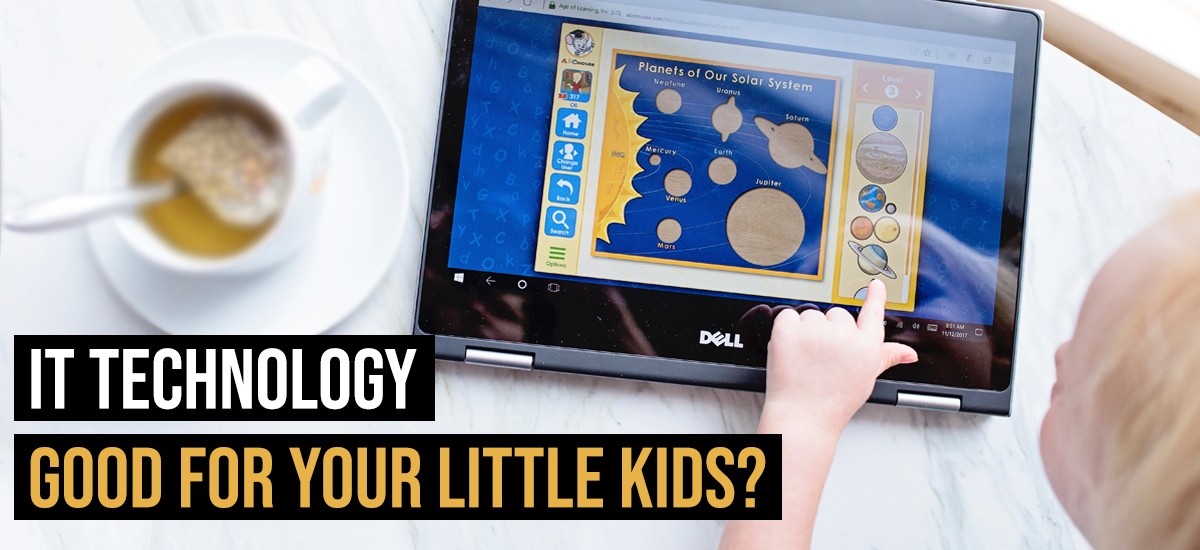IS TECHNOLOGY GOOD FOR YOUR LITTLE KIDS?

- April 26, 2018
- Digital Marketing , Uncategorized
This question is on many individuals minds. If you’ve at any point seen a youngster with a touchscreen computer like a cell phone or an iPad, it’s easy to understand why. The gadgets appear to captivate kids like a couple of things that have proceeded – dependably retaining them for a shockingly prolonged stretch of time. Furthermore, good luck taking one away!
Many parents encounter clashing sentiments about their children’s intense fascination with touchscreen computers. From one viewpoint, it can be challenging (and exhausting) endeavoring to keep a kid content throughout the day – especially during long auto car trips waiting up at eateries and the specialist’s office. Having a solid “high tech pacifier” some of the time comes in extremely helpful. What’s more, the way that children can draw in with intuitive applications rather than just inactively seeing recordings implies that they may even profit some way or another, by learning critical thinking abilities through amusements, for instance, or conveying everything that needs to be conveyed through advanced finger painting.
Then again, many parents stress over the open door expenses of “screen time” – that is, the time when kids aren’t exercising their bodies, associating with other people, or encountering the “genuine” world. Others expect that the gadgets may in truth be excessively captivating – that once a child has gone to the universe of Angry Birds and Fruit Ninjas they may never need to return…
The apparent paradox of digital technology
Parents are everywhere on the most proficient method to deal with their children’s access to touchscreen computers. At one extraordinary, a few children have unrestricted, unmonitored utilization of their very own gadgets and burn through many hours every week with them. At the opposite extreme, a few families attempt to keep their children totally “screen-free” for however many years as could reasonably be expected.
Parents oftentimes ask some version of the following question:
In what manner would it be a good idea for me to deal with my child’s opportunity in the advanced world so it doesn’t interfere with their comprehension and energy about the “genuine” world?
I intend to return to this inquiry in more depth in a future post. For the present, I need to investigate how it reveals insight into the contention numerous guardians encounter concerning their youngsters’ utilization of innovation, and how we may reframe the issue in a way that will enable them to move past that conflict.
I think that it’s interesting that at the core of this inquiry is a sort of mystery, in that the “digital” world is in the meantime observed as some way or another less genuine yet more convincing than the offline or “genuine” world.
Think for a minute: what else in our lives is both less genuine and furthermore more convincing than the options? Junk food and Ponzi plans come to mind. Junk food is less nutritious than whole food, however, when given a decision, individuals – particularly kids – frequently discover the junk food more engaging and appealing. Ponzi schemes are fiscally shocking contrasted with authentic budgetary speculations but then numerous individuals are tricked by their bogus guarantee of speedy wealth. In the event that these are the sorts of affiliations that come to mind for individuals when they consider youngsters and touchscreens, at that point it’s no big surprise they encounter uncertainty and uneasiness with respect to kids’ utilization of the innovation!
If we stop for a minute and reflect, however, we understand that such comparisons can’t in any way, shape or form is proper. Touchscreen computer is essentially methods for disseminating content, similar to supper plates or printer paper. Supper plates can deliver either junk food or entire nourishment. Essentially, touchscreen PCs can convey viable, formatively suitable learning encounters or “chewing gum for the eyes.” In every one of the three cases, to mark the plate, the paper, or the touchscreen PC as “great” or “awful” in total terms is to confound the conveyance medium with the content delivered.
In short: it makes sense that touchscreen PCs are not intrinsically great or terrible for kids, any more than supper plates or printer paper are inherently great or awful for them. It doesn’t, for instance, make sense to compare the devices directly to junk food or to entire food; they can be utilized to serve up what might as well be called either type. Everything relies on how we utilize them.
So what’s a parent to do?
While this move in context does not give hard rules to how to deal with children’s entrance to advanced innovation, it can help move the inquiries that are producing conflict in parents minds. Specifically, the either-or question “Is digital technology great or terrible for our children?” causes progressing worry for guardians on the grounds that there give off an impression of being huge outcomes for finding the solution wrong – yet the inquiry expressed that way doesn’t really have an answer. The outcome is that guardians continually struggle with whether they are making the best choice for their child, with not a single relief in sight.
A variety of that inquiry asks, “How much screen time is OK for my youngster?” This inquiry absolutely makes it less demanding to give particular rules – different associations have turned out with clear suggestions, for example, “no screen time through age two,” or “constraining screen time to one hour for each day is OK,” and so on. However, this resembles asking “to what extent should my youngster go through at the table with a supper plate before her during the day?” Setting a self-assertive time restraint doesn’t bode well. The imperative inquiry is: What are they expending from that supper plate and what amount of it?
- tags technology for kids


Leave a Reply
You must be logged in to post a comment.